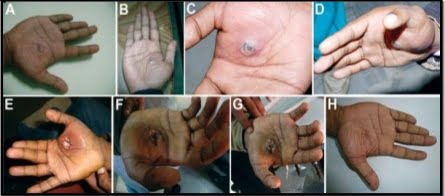Intoduction of BuffaloPox:
BuffaloPox virus disease is most emerging disease with 80% morbidity in affected herd population. These are large DNA viruses that are capable of infecting buffaloes, cows and humans mostly.It belongs to family Poxviridae which is subdivided into two subfamilies: Chordopoxvirinae (pox viruses of vertebrates) Entomopoxvirinae (pox viruses of insects). The subfamily Chordopoxvirinae is subdivided into eight genera and buffalo-pox is one of them. In buffaloes the disease outbreaks are may be allied with elevated morbidity rate and loss of production .
Disease Classification:
Buffalopox is one of the potential zoonotic disease and transmission mode of buffalopox to human beings are alike that of cowpox infections (FAO/WHO, 1967; Chandra et al., 1987). In human, gross lesions may appear in animal attendants and milk-men who are in close proximity with affected buffaloes.
Geographical Distribution:
Buffalopox cases mostly seen in India (outbreaks are reported from Maharashtra, Gujarat, Rajasthan, Andhra Pradesh, Tamilnadu and Karnataka states in India) and Egypt. The first recorded incidence of buffalopox was reported in Lahore in 1934 and was followed by frequent reports of outbreaks from various states of India. Disease also reported from Nepal, Bangladesh. In Pakistan, buffalopox caused a nosocomial infection (Hospital-acquired infections) in human beings (Zafar et al., 2007; Milton et al., 2015).
Causative agent:
The causative agent of buffalopox infection in buffalo is bufflopox virus. It is grouped in the subfamily of Chordopoxvirinae in the genus Orthopoxvirus in the family Poxviridae. BPXV is close to the clade of Vaccinia virus. C18L gene showed that BPXV isolates clustered into a different group which is distinct from VACV and remaining 99% related to vaccinia virus.The severity of the infection ranges from localized mild form to the infrequent severe generalized form. The infection poses economic impact due to reduced milk yield resultant from mastitis in milch animal and reduced working capacity in draft animals.
Physiochemical Properties of Buffalopox virus:
BPXV is least sensitive to ether and sensitive to bile salts, chloroform, extreme ranges of pH and heat. Heat inactivation of BP4 strain virus to 56o C for 90 minutes resulted in complete loss of infectivity.
Host range:
Buffalopx is mainly a disease of domestic buffaloes and occasionally causes limited lesions in milch cows and occasional oro-pharyngeal lesions in human beings due to consumption of unpasteurized milk. Buffaloes of all age groups and both sexes are affected, but the disease is severe in young and old animals..
Disease Transmission:
The buffalopox transmission in animals is natural. In humans, attendants and milkmen who are in close proximity with affected buffaloes are usually getting affected. Though the vector transmission is not been proved, biting flies like Musca vicina, Musca crossirostris and Lyperosia exigua have been reported to aggravate sores in animals. Therefore, it has been believed that flies may be implicated in transmission of BPXV mechanically.
Clinical Lesions:
Incubation period of disease is 2-4 days. The disease is characterized by pustular lesions on the teats and udders of milking buffalo. Lesions also can occur at the base of the ear and in the inguinal region. Rarely, especially in calves, a generalized disease occurs. sometimes producing lesions on the hands and face of milkers who are no longer protected by vaccination against smallpox. Secondary bacterial otitis may appear. In severe infections in milking animals may causes mastitis, with everlasting milk yield reduction

Diagnostic Procedures:
Clinical diagnosis can be made on the basis of clinical picture of typical pox lesions on udder, teats or affected body parts. But, it must be differentiated from other diseases affecting udder like cowpox, pseudo-cowpox and bovine herpesvirus mammilitis. Laboratory investigations are, therefore, essential for establishing a confirmatory diagnosis.
Differential diagnosis:
Cowpox, Pseudo-cowpox and bovine herpes virus mammilitis.
Therapeutic Treatment:
Certain drugs effective against OPV either in vitro and/ or in vivo are available viz. cidofovir, ST-246, STI-271, CMX001, cell penetrating peptides, imiquimod, gefitinib, nigericin, and herbal extracts.
Vaccination:
Not commercial available.
Reference:
Camelpox and Buffalopox: Two Emerging and Re-emerging Orthopox Viral Diseases of India
